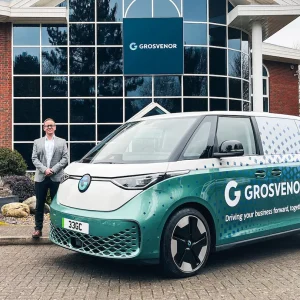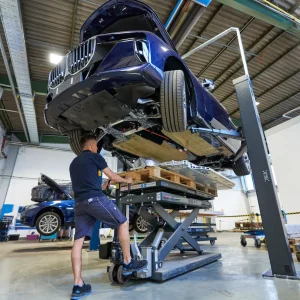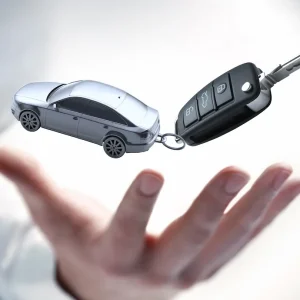Although the Metropolitan Police’s fleet is relatively contained within London and its outskirts, its fleet size and the mileage it covers is relatively high. As the largest police fleet in the country, the Met Police fleet, which consists of around 5,100 vehicles, covers in excess of 52 million miles per year.
But these vehicles are not just cars or vans patrolling the city streets. The Met Police’s fleet covers anything from pedal bikes and small scooters to lorries – not forgetting its contingent of marine vessels that police the River Thames – all of which bring their own set of operational challenges.
Responsibilities from the road to the river
The Met’s fleet is quite complex due to the many different driver and job roles the vehicles can be used for. Focusing in on the car side of the fleet and the response cars in particular account for the highest mileage of the road fleet, accumulating around 25,000 miles per year.
While most of the fleet’s mileage is accumulated in the Greater London area, some departments of the fleet have a wider counter-terrorism function outside of the capital.
“The majority of our car fleets are front line and respond to emergency incidents, but there are around 1,000 vehicles that do not respond to emergencies,” explains Jiggs Bharij, head of fleet services at the Met Police. “Instead, the focus of these vehicles is to support the operation of the police. We also look after the vehicles that protect the royal family and Her Majesty’s government.”
Due to the varied departments within the fleet, Bharij explains that there are a whole range of different types of vehicles that the Met uses for different operational situations and tactics, splitting the vehicles into categories consisting of, but not limited to: main front-line response, armed response, the road policing unit, prisoner transportation, protected vehicles (for use in planned events), and support vehicles, including forensic support. “Depending on what department the officer operates within and what type of activity they do will largely dictate what type of vehicle we will support them with,” explains Bharij.
Converting the fleet
The way the Met Police uses its vehicles is outside of the Road Traffic Act. But this doesn’t mean drivers can do whatever they want. In fact, it means an even greater responsibility for Bharij and his team to make sure the maintenance of the vehicles is sufficient to support the deployment activity and will keep his fleet safe.
As one can probably guess, these aren’t just any old vehicles leased and returned a few years later. “On the whole, our vehicles have to be bought outright because of the high-conversion requirements of the Met Police. Our cars need to accommodate police radios, communication equipment, all of the necessary policing equipment, dog kennels, and as you can guess, all that equipment needs maintenance,” says Bharij.
Reducing cost, therefore, isn’t very straightforward for this blue light fleet. Bharij tells us, “We have significant support infrastructure for purchase, repair and maintenance but we convert mostly all of our vehicles, which is a heavy expense. In terms of reducing that cost, it’s more about how we use our vehicles, how we deploy them and ensuring we are using them in the most efficient way.
“I also look closely at what improvements we can make around the types of vehicles we purchase for our operational roles, making reductions in the conversion cost, and whether we are maintaining them in the best way to support operational policing.”
The Met also has a ‘Safety Maturity’ assessment, which assesses its commitment to risk.
“Reducing collisions is key and we are committed to move up our Safety Maturity ranking, which is a significant internal commitment,” says Bharij.
All new officers complete ‘safe driving’ training, where they are also advised of the cost and profile of the Police asset they are driving. “We are developing a strategy for an on-going ‘safety culture’ instilled into officers over their entire career,” continues Bharij.
Running an efficient fleet
The fleet has been trialling telematics for its vehicles and is currently working on a project to deliver a vehicle telematics and camera solution for its road fleet. “We’re just scoping our requirements for what we need, how we need it, and how it will integrate with the systems we already have in the vehicle to help the fleet run more efficiently. Telematics will deliver a number of benefits, including greater insight into usage of the fleet, remote access of vehicle performance and collision data, as well as reducing several manual processes,” explains Bharij.
The main focus for Bharij and his fleet is to understand how he can achieve the best operation for each vehicle. “From a departmental perspective, it’s very much a focus on repair and maintenance, and whether we have it lined up to support operational policing in the right way,” he explains.
“I really want telematics to help us maximise vehicle availability because the last thing we want is a vehicle in our workshop under repair when it needs to be on the road, policing the capital,” says Bharij. “Then there’s the benefit telematics will provide to our operational data, making sure we have an officer and vehicle presence in crime hotspots when needed.”
Drive to zero emissions
As well as telematics advancements, Bharij and his team are also looking at how to improve the fleet’s emissions. Through its Enabling the Drive to Zero Emissions strategy, every vehicle on the Met’s fleet has been mapped out by an emission category for a planned transformation to a zero-emission fleet. Currently, less than 20% of the Met’s fleet is alternatively fuelled, but the aim is for that to significantly increase within the next few years, with a goal for all general purpose cars to be zero-emission capable by 2025.
The Met Police has been investigating which alternative fuel is best for its fleet and started trialling hydrogen vehicles in 2017, with help from EU funding. “We trialled hydrogen as we wanted to expand our knowledge and understanding of alternative fuel types,” Bharij says. “We didn’t restrict ourselves to just this one fuel type but used hydrogen on a mixture of response and support roles.”
Findings from the trial concluded that, while the operation, performance and how these vehicles were received by officers was a success, the limiting factor was the low number of hydrogen-refuelling stations in London.
“Since we started the project there haven’t been any new sites added to the list, so while the use of hydrogen in the Met Police fleet has potential, it’s seriously limited by refuelling options. We get the benefit of the speed in refuelling as we would in a petrol or diesel car, but the city just isn’t built for a hydrogen police fleet yet,” Bharij explains.
The Met’s zero-emission capable fleet, which covers electric and plug-in hybrid vehicles, has travelled more than 16.5 million miles since its first operation a few years ago, which is quite an achievement. So far, most of the electric use within the fleet has been in support cars, rather than the emergency response units. “These cars are not used 24 hours of the day so we have time during the day to put those vehicles on charge,” says Bharij.
The Forensic Support department, for instance, have deployed some Nissan e-NV200 vans, so they use these to support the forensic operation in London, which involves gathering forensic evidence from crime scenes. “These electric vans have been really well received by drivers and tend to be quite low-mileage vehicles anyway, because the operative tends to be at the scene for several hours before driving off to the next scene.
For that type of use, the Met Police has found electric vehicles to be perfect. But there are still some major obstacles to overcome when it comes to the mileage and payload requirements of the police force if these vehicles are to be rolled out into further departments. “Our vehicle assets are key to delivering an essential public service,” says Bharij. “Without suitable vehicles, officers cannot fulfil their vital role in keeping London safe.”
The biggest limitation Bharij has encountered when it comes to adopting more electric vehicles onto his fleet is payload.
The fleet’s Protected Carrier vehicle division, for example, requires a minibus to be modified and capable of protecting officers in particularly violent situations. “It has significant payload requirements and we’d need to identify an electric van that we could convert that would still meet our mileage requirements, which would mean allowing us to do several days of usage before exhausting the battery. As I mentioned before, we carry a lot of equipment that normal cars just don’t require and it has a significant impact on the range of the electric battery,” says Bharij. “We are determined to overcome this, however, and we are constantly talking to large manufacturers and giving them our requirements on what we need. Now, we’re just waiting to see if they bring the goods for what we need in two to three years.
“We are also about to trial our first fully-electric pursuit car, which really signals our intention in transitioning towards a greener fleet without compromising performance – we will always need vehicles that are equipped to meet rigorous demands of front-line policing.”
Like any fleet, the Met has significant concerns around charging infrastructure, but it has come up with a plan to ensure the infrastructure is not only in place, but also that every officer can locate a charging point with ease. “We’ve secured some plans to roll out infrastructure across our estate. Currently, there are 225 charging points on our estate and we’ve just installed our first rapid charger, which was a big milestone for us,” says Bharij.
“The longer-term plan is to install another 600 charging points over the next four years, and that involves identifying where we need the points and where we have the capacity to install them. That plan, coupled with the contracts we’ve put in place with several electricity providers to allow our vehicles to charge using public infrastructure, should put it in good stead to increase the number of EVs on our fleet.”
It’s fair to say Bharij has big plans for the Met Police fleet, but he highlights that the primary purpose of the fleet is to keep the Met Police mobile and keep supporting policing around the capital as efficiently as possible.
“The move to zero emissions must not have a negative impact on officer mobility – in fact, it sits alongside other strategies that will introduce better use of technology and improved efficiencies to increase vehicle availability and limit downtime,” he says.





